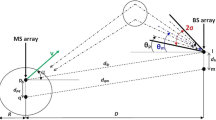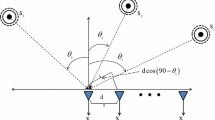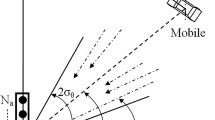Abstract
We consider the performance analysis of the maximum-likelihood (ML) angle-of-arrival (AOA) estimation algorithm in this paper. Based on the observation that the ML AOA spectrum is noncentral chi-square distributed with known degree of freedom and known noncentrality, we propose how to numerically evaluate the probability density function of the difference between two ML spectra associated with two different directions. By judiciously choosing the two different angles, we can analytically determine the probability that the ML spectrum at the nearest grid is greater than the ML spectrum at the second nearest grid by arbitrary value. Numerical examples are used to validate the derived expressions.


Similar content being viewed by others
References
M.L. Bencheikh, Y. Wang, Combined ESPRIT-RootMUSIC for DOA-DOD estimation in polarimetric bistatic MIMO radar. Prog. Electromagn. Res. Lett. 22, 109–117 (2011)
D. Byrne, M. O’Halloran, M. Glavin, E. Jones, Data independent radar beamforming algorithms for breast cancer detection. Prog. Electromagn. Res. 107, 331–348 (2010)
S.-W. Cho, J.-H. Lee, Efficient implementation of the Capon beamforming using the Levenberg–Marquardt scheme for two dimensional AOA estimation. Prog. Electromagn. Res. 137, 19–34 (2013)
A. Ferrol, P. Larzabal, M. Viberg, On the asymptotic performance analysis of subspace DOA estimation in the presence of modeling errors: case of MUSIC. IEEE Trans. Signal Process. 54(3), 907–920 (2006)
X. Gu, Y. Zhang, Resolution threshold analysis of MUSIC algorithm in radar range imaging. Prog. Electromagn. Res. B 31, 297–321 (2011)
R.A. Horn, C.R. Johnson, Matrix analysis (Cambridge Univ. Press, Cambridge, 1986)
H. Krim, P. Forster, J.G. Proakis, Operator approach to performance analysis of root-MUSIC and root-min-norm. IEEE Trans. Signal Process. 40(7), 1687–1696 (1992)
J.-H. Lee, S.-W. Cho, I.-S. Choi, Newton-type method in spectrum estimaion-based AOA estimation. IEICE Electron. Exp. 9(14) (2012)
J.-H. Lee, Y.-S. Jeong, S.-W. Cho, W.-Y. Yeo, K.S.J. Pister, Application of the Newton method to improve the accuracy of TOA estimation with the beamforming algorithm and the MUSIC algorithm. Prog. Electromagn. Res. 116, 475–515 (2011)
J.-H. Lee, S.-W. Cho, S.-H. Jeong, Application of the Levenberg–Marquardt scheme to the MUSIC algorithm for AOA estimation. Int. J. Antennas and Propag. 402842, 1–8 (2013)
J.-H. Lee, S.-W. Cho, H.-J. Moon, Application of the alternating projection strategy to the Capon beamforming and the MUSIC algorithm for azimuth/elevation AOA estimation. J. Electromagn. Waves Appl. 27(12), 1439–1454 (2013)
J.-H. Lee, S.-W. Cho, Performance improvement of the AOA estimation algorithm using the Newton iteration. Appl. Comput. Electromagn. Soc. J. 28(3), 249–272 (2013)
J. Liang, D. Liu, Two L-shaped array-based 2-D DOAs estimation in the presence of mutual coupling. Prog. Electromagn. Res. 112, 273–298 (2011)
Y. Li, H. Ling, Improved current decomposition in helical antennas using the ESPRIT algorithm. Prog. Electromagn. Res. 106, 279–293 (2010)
J.E. Mooney, Z. Ding, L.S. Riggs, Performance analysis of a GLRT automated target discrimination scheme. IEEE Trans. Antennas Propag. 49(12), 1827–1835 (2001)
S.U. Pillai, B.H. Kwon, Performance analysis of MUSIC-type high resolution estimators for direction finding in correlated and coherent scenes. IEEE Trans. Acoust. Speech Signal Process. 37(8), 1176–1189 (1989)
B.D. Rao, K.V.S. Hari, Performance analysis of root-MUSIC. IEEE Trans. Acoust. Speech Signal Process. 37(8), 1939–1949 (1989)
P. Stoica, A. Nehorai, MUSIC, maximum likelihood, and Cramer–Rao bound. IEEE Trans. Acoust. Speech Signal Process. 37(5), 720–741 (1989)
P. Stoica, A. Nehorai, MUSIC, maximum likelihood, and Cramer–Rao bound: further results and comparisons. IEEE Trans. Acoust. Speech Signal Process. 38(12), 2140–2150 (1990)
A.L. Swindlehurst, T. Kailath, A performance analysis of subspace-based methods in the presence of model errors. I. The MUSIC algorithm. IEEE Trans. Signal Process. 40(7), 1758–1774 (1992)
P. Yang, F. Yang, Z.-P. Nie, DOA estimation with sub-array divided technique and interporlated ESPRIT algorithm on a cylindrical conformal array antenna. Prog. Electromagn. Res. 103, 201–216 (2010)
Q.T. Zhang, Probability of resolution of the MUSIC algorithm. IEEE Trans. Signal Process. 43(4), 978–987 (1995)
W. Zhang, A. Hoorfar, L. Li, Through-the-wall target localization with time reversal MUSIC method. Prog. Electromagn. Res. 106, 75–89 (2010)
Acknowledgments
This research was supported by Basic Science Research Program through the National Research Foundation of Korea (NRF) funded by the Ministry of Education (2013R1A1A2A10012245).
Author information
Authors and Affiliations
Corresponding author
Rights and permissions
About this article
Cite this article
Lee, JH., Cho, SW., Jeong, SH. et al. Statistical Distribution of Difference of the Maximum-Likelihood Angle-of-Arrival Spectra. Circuits Syst Signal Process 35, 1705–1727 (2016). https://doi.org/10.1007/s00034-015-0141-2
Received:
Revised:
Accepted:
Published:
Issue Date:
DOI: https://doi.org/10.1007/s00034-015-0141-2




